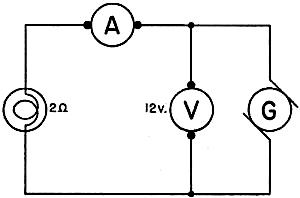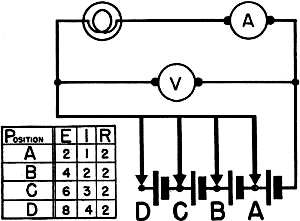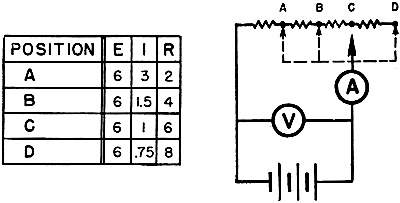|
Electricity - Basic Navy Training Courses NAVPERS 10622 |
||||||||||||||||||||
|
Here is the "Electricity - Basic Navy Training Courses" (NAVPERS 10622) in its entirety. It should provide one of the Internet's best resources for people seeking a basic electricity course - complete with examples worked out. See copyright. See Table of Contents.
¶ U.S. GOVERNMENT PRINTING OFFICE; 1945 - 618779
CHAPTER 6 During the late 1700's and early 1800's, three great electrical discoveries were made. An Italian, named Volta, discovered haw to. produce an emf from a primary cell. He gave his name to. the measuring unit of electromotive force - the VOLT. Ampere, a Frenchman, measured current flaw and gave his name to. the measuring unit of current - the AMPERE. A German, named Ohm, measured the resistance of circuits and conductors and gave his name to the resistance measuring unit - the OHM. Ohm did more than experiment with resistance -he connected his awn discoveries with those of Volta and Ampere. The result was OHM'S LAW. Make sure you understand each one of the three quantities in electricity - they make up Ohm's Law. On the following page is a table of these important quantities, their symbols, their units, their abbreviations, and their effects an a circuit.
WHAT IS OHM'S LAW? You know that increasing the potential ,will IN-CREASE the current. Likewise, increasing the resistance will DECREASE the current. Ohm's law is this relationship of emf, current, and resistance expressed in mathematical terms. It says - I=E/R That is, the current, I (in amps) equals the emf, E (in volts) divided by the resistance R, (in ohms). Figure 31 shows a simple electrical circuit - generator, load, and connecting wires. In this case, the load is a lamp, but ANY electrical appliance is a LOAD. Notice the ammeter connected to read' the current and the voltmeter connected to read the emf of the generator. If the resistance of this circuit is 2 ohms and the emf read on the voltmeter is 12 volts, then - I=E/R=12/2=6amps.
Figure 31. - Simple circuit, voltage constant. The ammeter will read 6 amperes. Which means that the load draws 6 amperes.
Figure 32. - Effect of voltage on current, R is constant. Imagine that a battery of cells is used, instead o£ a generator, as an emf source. The circuit. would look like figure 32. Each cell produces 2 volts. Notice that connecting the line at-A, B, C, or D, CHANGES the number of cells included in the' circuit. This will give you voltages of 2, 4, 6, and 8 volts. The table at the. left of the diagram gives the current flowing for each voltage. For each value of voltage, the current is calculated by Ohm's law. Remember, current is DIRECTLY proportional to voltage.
Figure 33. - Effect of resistance on current, E is constant. CONCLUSION - In any electrical circuit, IF YOU HOLD THE RESISTANCE CONSTANT AND INCREASE THE VOLTAGE, THE CURRENT INCREASES IN PROPORTION TO THE IN-CREASE IN VOLTAGE. IF YOU HOLD THE RESISTANCE CONSTANT AND DECREASE THE VOLTAGE, THE CURRENT DECREASES IN PROPORTION TO. THE DECREASE IN VOLTAGE. Take a look at figure 33. In this circuit, the voltage remains constant, but the resistance of the load is 2,4, 6, or 8 ohms depending on which tap, A, B, C, or D is connected. In the table at the left of the figure, the current flow is given for each connection. Notice that current is INVERSELY proportional to resistance.
CONCLUSION - In any electrical circuit, IF YOU HOLD THE VOLTAGE CONSTANT AND INCREASE THE RESISTANCE, THE CURRENT DECREASES IN PROPORTION TO THE INCREASE IN RESISTANCE. IF YOU HOLD THE VOLTAGE CONSTANT AND DECREASE THE RESISTANCE, THE CURRENT INCREASES IN PROPORTION TO THE DECREASE IN RESISTANCE. Reviewing the tables in figures 32 and 33, you will find that any number in the current column I, can be obtained by dividing the voltage by the resistance.
I=E/R Any number in the resistance column R, can be found by dividing the voltage by the current. R=E/I Furthermore, any number in the voltage column, E, can be obtained by multiplying the current and the resistance. E=IR From your knowledge of mathematics, you recognize that these three equations are variations of one formula. I=E/R, R=E/I, and E=IR If you know any two of these quantities in a circuit, or in any part of a circuit, you can calculate the other quantity by applying the proper equation. EXAMPLES 1. A vacuum tube filament has a resistance of 12 ohms when connected to a 6-volt battery. What is the current in the filament? I=E/R=6/12=1/2 amp. 2. An ignition coil draws 8 amperes at 6 volts. What is the resistance of the coil? R=E/I=6/8=3/4 ohm. 3. A starter motor has a resistance of 0.04 ohm and draws 150 amperes at starting. What is the voltage applied to this motor? E=IR=0.04x150=6 volts. REMEMBER THESE POINTS - 1. The strength of the electrical CURRENT, or amperage, depends on the RESISTANCE of the circuit AND the VOLTAGE applied to the circuit. Ohm's law will tell you how much current is flowing. 2. The RESISTANCE does not depend on either current or voltage. The character of the conducting path - wires and load - determine the resistance. You DO NOT change resistance by changing current or voltage. Ohm's law will tell you how much resistance is contained in the circuit. 3. The emf of a circuit does NOT depend on either CURRENT or RESISTANCE. The emf is determined entirely by the generator or battery supplying the circuit. Ohm's law will tell you how much voltage is required for a given current through a given resistance. Chapter 6 Quiz
|
||||||||||||||||||||



